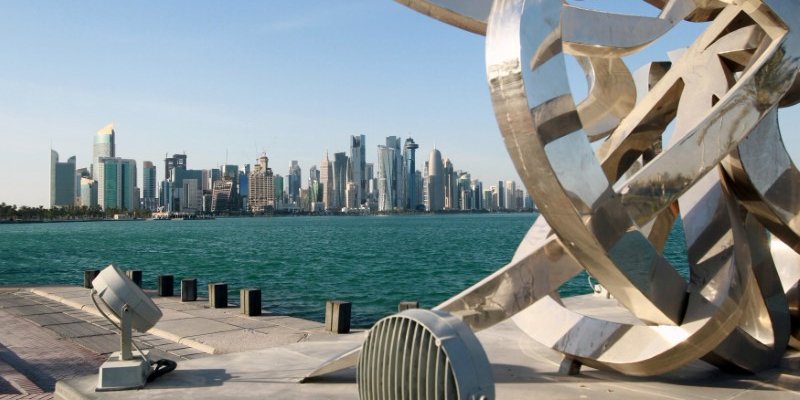 Buildings are seen from across the water in DohaThomson Reuters
Buildings are seen from across the water in DohaThomson Reuters
- The Saudi-led blockade of Qatar may be halting progress on the construction of three stadiums planned for the 2022 World Cup.
- Satellite imagery shows little progress was made on three stadia, which are due to be completed in 2019 and 2020.
- Only one of the eight stadia has been completed so far.
LONDON — The Saudi-led blockade of Qatar may be halting progress on the construction of three stadia being built for the 2022 World Cup.
Satellite imagery analysed by tech startup Bird.i appears to show little progress has been made since June on three of the eight planned stadiums in Qatar. A minimum of eight playing venues are required by FIFA for the World Cup to take place.
Qatar imports a large proportion of its construction materials, as well as other essentials such as food, most of which have historically come through Saudi Arabia and other Gulf countries. But Saudi Arabia, the United Arab Emirates, Bahrain and Egypt cut diplomatic ties with the country in June, making accessing supplies more difficult.
Speaking to Business Insider in 2017, Mark O’Connell, CEO at investment advisory firm OCO Global, warned projects in Qatar were “on hold in many cases,” and questioned the “realism” of the country being able to host the World Cup.
Satellite imagery shows little progress has been made this year on Lusail Iconic Stadium, in Lusail, particularly since the blockade began in June. This can be seen in the series of images from March, June, September and December 2017 (below).
The latest image still shows little more than foundations, but completion is scheduled for 2019.
![]() Lusail Iconic stadium in March 2017.Copyright © Birdi Ltd. – Image © 2017 DigitalGlobe, Inc.
Lusail Iconic stadium in March 2017.Copyright © Birdi Ltd. – Image © 2017 DigitalGlobe, Inc.
![]() Lusail Iconic stadium in June 2017.Copyright © Birdi Ltd. – Image © 2017 DigitalGlobe, Inc.
Lusail Iconic stadium in June 2017.Copyright © Birdi Ltd. – Image © 2017 DigitalGlobe, Inc.
![]() Lusail Iconic stadium in September 2017.Copyright © Birdi Ltd. – Image © 2017 DigitalGlobe, Inc.
Lusail Iconic stadium in September 2017.Copyright © Birdi Ltd. – Image © 2017 DigitalGlobe, Inc.
![]() Lusail Iconic stadium in December 2017. Although some progress can be seen, there’s still a long way to go.Copyright © Birdi Ltd. – Image © 2017 DigitalGlobe, Inc.
Lusail Iconic stadium in December 2017. Although some progress can be seen, there’s still a long way to go.Copyright © Birdi Ltd. – Image © 2017 DigitalGlobe, Inc.
Al Rayyan Stadium, which is close to the Qatari capital Doha, has also seen little progress over the last 12 months.
The latest image (below), from December 16, 2017, shows foundations and the beginnings of a structure — but the planned completion date is in just over a year. According to Corentin Guillo, founder and CEO at Bird.i, progress has slowed since the blockade began.
 Al Rayyan stadium in December 2017.Copyright © Birdi Ltd. – Image © 2017 DigitalGlobe, Inc.
Al Rayyan stadium in December 2017.Copyright © Birdi Ltd. – Image © 2017 DigitalGlobe, Inc.
Ras Abu Abboud, in Doha, is scheduled for completion in 2020.
But, analysis of the latest image from November 29, 2017 (below), shows its exact location is still uncertain, and no building work had been detected.
 Ras Abu Abboud stadium, November 2017.Copyright © Birdi Ltd. – Image © 2017 DigitalGlobe, Inc.
Ras Abu Abboud stadium, November 2017.Copyright © Birdi Ltd. – Image © 2017 DigitalGlobe, Inc.
By comparison, Al Thumama Stadium, in Doha, has seen much more progress this year, and is due to be completed in 2020.
The images below are from July and November 2017.
 Al Thumama stadium in July 2017.Copyright © Birdi Ltd. – Image © 2017 DigitalGlobe, Inc.
Al Thumama stadium in July 2017.Copyright © Birdi Ltd. – Image © 2017 DigitalGlobe, Inc.
 Al Thumama stadium in November 2017.Copyright © Birdi Ltd. – Image © 2017 DigitalGlobe, Inc.
Al Thumama stadium in November 2017.Copyright © Birdi Ltd. – Image © 2017 DigitalGlobe, Inc.
The only fully built stadium so far is Khalifa International Stadium in Doha, which can be seen below:
 Khalifa International stadium, which is complete.Copyright © Birdi Ltd. – Image © 2017 DigitalGlobe, Inc.
Khalifa International stadium, which is complete.Copyright © Birdi Ltd. – Image © 2017 DigitalGlobe, Inc.
Qatar’s total imports were down 40% in June 2017 compared to 2016, and ratings agency Moody’s predicted in September the country spent $40 billion supporting its economy in the first two months of the blockade alone.
Progress is varied across the remaining four stadia: Al Bayt Stadium is still at the foundation stages, but some progress was made throughout 2017. Meanwhile, Al Thumama, Al Wakrah and Education City stadia all saw progress in the second and third quarters of 2017. According to Guillo, they are not yet causes for concern.
The World Cup Local Organising Committee in Qatar could not be reached for comment.













